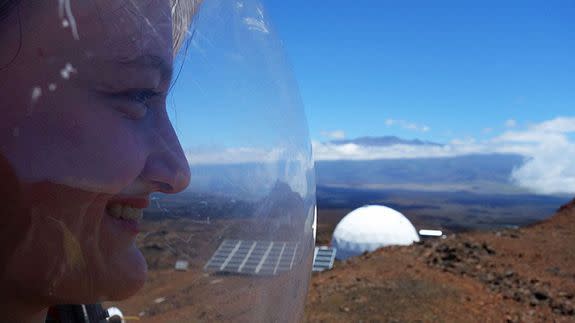Crew of simulated Mars mission 'returns' to Earth after one year

After spending an entire year living in the isolation of a simulated mission to Mars, the crew of the Hawaii Space Exploration Analog & Simulation (HI-SEAS) project finally emerged on Sunday, and they looked very relieved.
SEE ALSO: NASA just made a very important step toward getting humans to Mars
Although high-profile space professionals like Elon Musk often talk about sending a manned mission to Mars, the reality is that such a mission would put the astronauts to the ultimate test of endurance on both a physical and psychological level.

Image: HI-Seas
Matt Damon made it look like a relative rough day of camping in The Martian, but intense, extended simulations like HI-SEAS are, for now, one of the best ways to give us a real clue as to just how tough such a mission might really be.
The crew was made up of a diverse team of experts, including Sheyna Gifford, a science researcher, Tristan Bassingthwaighte, an architect, Carmel Johnston, a soil scientist, Andrzej Stewart, a pilot and former Lockheed Martin employee, Cyprien Verseux, an astrobiologist, and Christiane Heinicke, a physicist and engineer. They lived in a habitat on the slopes of the Mauna Loa volcano on the island of Hawaii.
"A mission to Mars in the near future is realistic. I think the technological and psychological [challenges] can be overcome," said HI-SEAS crew member and researcher Verseux, during a Periscope chat on Sunday. "For me, being here was an excellent opportunity to see what the real constraints of a mission to Mars are. "
The crew was monitored the entire time, however, it appears that the specific findings of the simulated mission are being kept under wraps for now. Nevertheless, the "mission" is giving us a good idea of what the rigors of living on another planet may entail — and they're not as epic as in a science fiction movie.
"Bring something meaningful to work on, said crew member Christiane Heinicke during another Periscope interview on Sunday. "One of the biggest enemies is boredom."
Heinicke also talked about the challenges of working with the same people in such close proximity for such a long time, noting that sudden emergencies actually help to bring the crew together and make the extended time together a bit more bearable.
The HI-SEAS program is already recruiting its next batch of virtual astronauts, so if you've ever wanted to test your space-faring skills, this might be your chance. The next eight month mission will begin in January 2017 and will be located in "an isolated Mars-like environment" on the Big Island of Hawaii at roughly 8,200 feet above sea level.
The deadline for applications is September 5.
